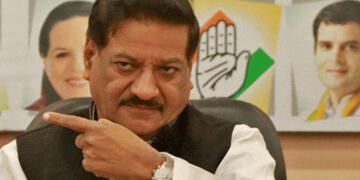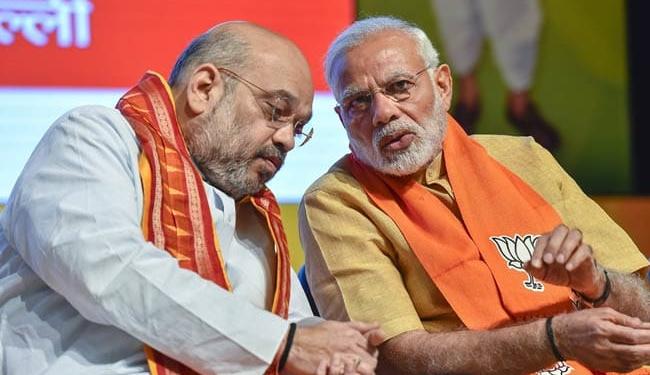If someone ever asks me to show the most perfect professional on this planet, I’ll without doubt point at Yogendra Yadav and say, “Look, this guy is the embodiment of perfection when it comes to making bizarre electoral predictions. He is the undisputed king of the wrong predictions. If making wrong electoral predictions was a proper profession then this man would be the most perfect professional, a connoisseur of his trade.”
As the nation watched with rapt attention, a severely fought election in Uttar Pradesh where niceties were put inside a cupboard and locked forever a sweet speaking Yogendra Yadav predicted a ‘hung assembly’ with ‘BJP ahead’. BJP went on to register a landslide victory with 325 seats.
Then came the Gujarat elections, the master predicted a drubbing for the BJP in Gujarat elections. BJP emerged victorious in the elections registering their best performance in terms of vote share.
The undisputed king of wrong predictions is back again with one more prediction. Yogendra Yadav said, “As things stand today, the BJP is staring at a loss of 100 seats from the peak it attained in 2014. Unless something changes dramatically, there is no way the BJP can touch the 200-seat mark necessary for it to cobble up a majority. That would effectively put paid to Mr. Modi’s prospects of a re-election.”
According to Yogendra Yadav, “the Hindi heartland is where the battle of 2019 will be won or lost.” He predicted, “As things stand today, the BJP could lose up to 50 seats in UP alone and another 50 in the rest of the Hindi heartland.” If these predictions are anything at all, they could conveniently be ignored as the rants of a confused predictor.
But let’s not ignore Yogendra Yadav’s predictions. Let’s analyze!
Hindi Heartland is comprised of Bihar, Uttar Pradesh, Jharkhand, Uttarakhand, Madhya Pradesh, Chhattisgarh, Rajasthan, Delhi, Haryana, Chandigarh, Himachal Pradesh.
He provided state wise reasons and painted a bleak picture for the BJP in Hindi heartland. For Jharkhand, Haryana and Uttarakhand, Yogendra Yadav said that the surveys suggest that the BJP government is very unpopular in these states and, “would cost the party at least 10 seats in these three states. About Delhi, he said “the party is not in a position to repeat its sweep in Delhi.” That’s the thing with great artists, they never allow facts to contaminate their beautiful vision. When analyzed closely Mr. Yadav’s doomsday prediction for the BJP in these states fall flat. Even if we, for the sake of argument assume that the BJP is unpopular in these states then the obvious corollary is that the opposition parties in these states are stronger. But are they? No, they are not. They are weaker and more unpopular than the BJP.
Let us begin with Haryana first. Here the recent Indian National Lok Dal’s ‘very’ public family feud is known to everyone. Recently, INLD President Om Prakash Chautala removed his two grandsons from the party for ‘indiscipline’, widening the rift within the family. Earlier, Hisar MP Dushyant Chautala and youth leader Digvijay Chautala, both sons of Chautala’s elder son Ajay Chautala, were expelled from the primary membership of the party.
Congress’ royal rumble is no less. Former MP Ashok Tanwar and former CM Bhupinder Singh Hooda have been attacking each other openly and frequently. More importantly, Congress high command has allowed the wrestling match to continue without a fuss.
The no-non-sense CM that Manohar lal Khattar has focused on governance while leaving the game of political mudslinging for the opposition. On 30th October, Manohar Lal Khattar-led BJP has completed its four years of governance in Haryana. CM Khattar attracted both criticism and praises for his governance. Khattar government was targeted on issues such as Jat agitation, Dera riots and Rampal Jailing. On the other hand, it received laurels for the development related works. Other initiatives such as The Beti Bachao, Beti Padhao (BBBP) programme, CM Window, E-Governance, E-Bhoomi portal has been a huge success. Irrigation, power structure and electricity supply has registered upward trend. Many institutes of higher education have been setup in the state. One of the major achievements of Khattar government is steps taken by it to decongest Gurugram. It launched multiple development projects including flyover, over bridges, underpasses etc. to decongest the city. Its effects are clearly visible on the grounds.
So, we see how he is right on track when it comes to core governance.
When people will go out to cast their mandate in 2019 Lok Sabha elections, they will decide whom to vote based on work done by the party. Furthermore, the fact that he is a Punjabi CM of a state long dominated by Jats whose votes are going to be split if INLD decides to stay away from the Congress led coalition. The Khattar government remains very popular among the people in the state, however the former pracharak of the sangh is very unpopular among Lutyens media, which clearly reflects in Mr. Yadav’s bizarre prediction too.
Same goes for Jharkhand as well. The BJP provided much needed political stability to the state. The mineral rich state of Jharkhand had seen much political drama prior to 2014. Such was the condition of the state before 2014 state elections that not even one Chief Minister prior to the incumbent CM had been able to complete his full term. Within a year of becoming the CM, Raghubar Das acted fast to build its own set of rules in compliance with the provisions of the Land Acquisition bill which was yet to be cleared in the Parliament by the central government. ‘Jharkhand Right to Fair Compensation and Transparency in Land Acquisition, Rehabilitation and Resettlement Rules-2015’ was made taking into consideration the large number of tribal dominated areas which come under 5th Schedule of the Constitution.
Under Raghubar Das Jharkhand became the first state to ban Popular Front of India (PFI) in the state. The government also passed the anti-conversion bill in the state which had provisions of imprisonment of three years and fine of Rs 50,000 or both, and four year- imprisonment and Rs 1 lakh fine, or both, if the person converted is a minor, woman or a member of Scheduled Caste or Scheduled Tribe.
One brave decision was quickly followed by another when Raghubar Das announced that the benefits reserved for Scheduled Tribes could not be availed by people who had converted.
Raghubar Das has Hindutva appeal of Yogi Adityanath and development aptitude of Devendra Fadnavis. And, hence his government remains very popular in the state contrary to the claims made by illusionist Yogendra Yadav. Under his strong leadership in the state coupled with Modi Tsunami, the BJP is likely repeat its 2014 like performance again. to add to it, Jharkhand has ZERO opposition. Congress is down and out and JMM is staring at its last elections in the state.
Uttarakhand is a crucial state for the BJP. In March 2017, the BJP came to power with thumping majority, decimating the Congress which was reduced to 11 out of 70 seats. The highly unpopular Congress rule was marked by rampant corruption and mismanagement in the state especially during the 2013 Kedarnath tragedy. The BJP promised corruption free government and development-oriented governance. As promised, BJP CM Rawat began probe into the alleged Rs 300-crore scam in land acquisition for the NH-74.
CM Rawat also launched a special campaign to check illegal mining in the state. In addition to checking the corruption, the Chardham all-weather road, Rishikesh-Karnprayag railway line, and the Kedarnath reconstruction project, foundation stone of which was laid by PM Modi were some of the key projects that were initiated in the state.
Under UDAN Yojana, state government has laid special focus on air connectivity as well.
PM Modi has visited state many times. He celebrated this year’s Diwali in Uttarakhand. PM Modi also attended Uttarakhand investors summit held in October this year. According to reports, PM Modi will inaugurate CNG pipeline project between Dehradun to Haridwar on November 22.
Uttarakhand has 5 Lok Sabha seats and the BJP won all of them in 2014 general elections. The way things are going it is no exaggeration to say that the BJP might repeat its 2014 performance again in the state.
Now coming to Delhi, contrary to the claims of Yogendra Yadav, the BJP is in a very strong position in the state and it is most likely to sweep the region again just like it did in 2014. The strongest reason behind it is the declining popularity of CM Arvind Kejriwal who leads one of the most incompetent governments in the country marred with corruption and confrontational politics. Congress is completely uprooted from the state and is in no state to recover. Nothing can stop BJP from repeating its 2014 performance again in the special state.
Yogendra Yadav further predicts, “While there are different projections of the mood of the electorate in the upcoming assembly elections, everyone agrees that the BJP faces a rout in Rajasthan and a serious challenge in Madhya Pradesh and Chhattisgarh. Past records show that in these states, the assembly verdict is repeated in the Lok Sabha results. If so, the BJP could easily lose 30 seats in these poll-bound states. All in all, the BJP is looking at a loss of up to 50 seats in these Hindi-speaking states.”
Let’s analyze electoral conditions in Chhattisgarh, Rajasthan and Madhya Pradesh. We would analyze the electoral prospect of parties for the upcoming state assembly elections as it plays a crucial role in deciding the outcome of Lok Sabha electoral results. Yogendra Yadav also observed the same. Beginning with Chhattisgarh, it is BJP’s stronghold. This time the Congress party strongly believes that it can defeat the BJP in the state because there is huge anti-incumbency against the ruling party in the state.
Last month, Ram Dayal Uike, senior leader of the Congress party who happened to be the state executive president as well – joined the BJP. The BJP President inducted Ram Dayal Uike into the BJP in the presence of Chief Minister Raman Singh, in Bilaspur. However, the Grand Old Party received its biggest jolt in September when Mayawati snubbed the Congress. The BSP declared to contest in the upcoming Chhattisgarh state assembly elections in coalition with Ajit Jogi’s Janata Congress Chhattisgarh (JCC-J). BSP supremo also made it very clear that if the government of the BSP- JCC came to power then Ajit Jogi will be the Chief Ministerial candidate. In Chhattisgarh, the BSP will contest on 35 seats and JCC will fight on the remaining 55 seats. One of the reasons why BSP decided to go with JCC is perhaps the Congress party was not willing to give more than 5 seats to the BSP.
The pre-poll alliance between the BSP-JCC is seen as a major setback to the dreams of the Grand Old Party which had been trying to throw BJP out of power which has been ruling the state from the past 15 years. In fact, former Congress leader and now the CM candidate of BSP-JCC alliance- Ajit Jogi is trying to turn the assembly elections into a triangular contest and any such contest is most likely to benefit the BJP, as it will chop the votes of the Congress. In Chhattisgarh, shift of even 1% of the votes is enough to alter the equations drastically. In the last state assembly elections, both parties- Congress and BJP had a vote difference of just below 1 percent.
To make the case worse for the Congress, the party failed to stitch up an alliance with Mayawati. Mayawati’s BSP got 4.27% vote share in the last state assembly elections. The veteran journalist Ramesh Nayyar told PTI, “The Congress has suffered a major setback with the move as it was attempting to take the BSP to its side for the upcoming election, in view of the latter’s hold among Scheduled Caste population, particularly the Satnami community, in districts like Janjgir-Champa, Raigarh and Bilaspur.” The BSP has considerable presence on around 11 seats.
Historically the elections in Chhattisgarh have been closely fought and Ajit Jogi-Mayawati alliance will lead to division of the anti-BJP votes or anti-incumbency votes which will ultimately end up benefiting BJP.
Furthermore, there are three claimants for the post of the CM from Congress’ side- Bhupesh Baghel (Pradesh Congress Committee chief), T.S. Singh Deo (Leader of Opposition) and Charan Das Mahant (former Union Minister and MP from Korba). Apart from these three, according to Congress party leaders, a fourth person- Tamradhwaj Sahu, MP from Durg and president of All India Congress Committee’s OBC wing- is likely to emerge as the strongest candidate for the post of CM. This infighting is bound to hurt the party’s prospect in the upcoming elections, state as well as Lok Sabha elections.
Same goes for Rajasthan. Former CM of Rajasthan Ashok Gehlot has expressed the desire to remain in the state to solidify his position for the CM chair. While Rahul Gandhi is keen on considering Sachin Pilot’s name for the CM post, some statements given by Gehlot and his supporters have wreaked havoc in the camps of the Congress. Both camps are locked in a game of muscle flexing and posturing.
To mitigate the damage, Congress high command has decided to contest polls under a “collective leadership”.
The return of MLA Kirodi Lal Meena is a big boost for the BJP ahead of the assembly elections. Meena, a five-term MLA and two-time MP, is an influential leader and his community has a significant presence in 28 assembly seats in 11 districts of eastern Rajasthan.
Launch of new political outfit by Jat Leader Hanuman Beniwal can be blessing in disguise for BJP as Jat’s are majorly Congress supporters in the state and this new outfit will split Congress’ overall votes.
PM Modi remains one of the crucial factors. The Modi factor is still very strong in Rajasthan. In 2014 national elections, as per CSDS post poll survey, 42% of BJP voters said they would not have voted for the party if Narendra Modi weren’t the PM candidate, the national average was only 27%. As per India Today – Axis Political Stock Exchange released on 7 September 2018, 57% of the respondents want to see Modi as PM versus 35 per cent for Rahul Gandhi, a lead of 22 per cent. About 46% respondents rate the performance of Modi as good while another 12 per cent as average, exhibiting strong satisfaction with his performance.
Coming to Madhya Pradesh, as the polling day approaches, the infighting within the Congress is getting more and more intensified in the state. The party has released six lists of the candidates for the MP polls. The party would contest on 229 out of 230 seats leaving the ‘Jatara‘ seat. The lists exposed the severe infighting and ideological fault lines that exists in the Congress party. Vyapam whistleblower, Dr Anand Rai is upset over not getting ticket despite promises from Congress Party President Rahul Gandhi.
The Grand Old Party is divided and the BJP being aware of this has attacked the Congress over the ongoing infighting. The BJP spokesperson Sambit Patra mocked the Congress and said, “Rahul is a confused president and under a confused president, the Congress is defused. The kind of infighting within the Congress…Digvijay Singh takes on Jyotiraditya Scindia openly and that too in front of Rahul Gandhi.” He further said, “The people of this country are not confused. They want a strong government and not a weak government.”
In Madhya Pradesh, the Congress is divided into three factions- Scindia, Digvijay and Kamalnath. Although, Digvijay Singh has been steadily side-lined for the last few months, Kamal Nath was made in-charge of the MP election campaign.
The Congress is going to face lot of difficulties in Madhya Pradesh because of its infighting. It will spoil party’s electoral prospect not just in state assembly elections but also in 2019 Lok Sabha elections.
And now comes the state which is considered the most crucial for the electoral prospects of the BJP. No prizes for guessing, we are talking about Uttar Pradesh. Yogendra Yadav predicts that the SP-BSP alliance can defeat the BJP in about 50 seats. He further says, “To make matters worse for the ruling party, polls suggest that the Yogi Adityanath government is losing popular traction within two years of its historic victory. As things stand today, the BJP could lose up to 50 seats in UP alone and another 50 in the rest of the Hindi heartland.”
Even the SP and BSP would not be this optimistic about defeating the BJP. Their alliance is vulnerable and fragile, and both the parties are going through their worst phase. All is not well within the SP. In September, the SP strongman, Shivpal Yadav formed his own ‘Secular Morcha.’ He has given place to big faces that were once a part of the Akhilesh’s cabinet. It includes the names of Shadab Fatima and Sharda Pratap Shukla. Shivpal Yadav had asked the loyal members to join his faction for the sake of old loyalties, especially towards the ex supremo Mulayam Singh Yadav. Shivpal Yadav has the support of some of the senior and strong members of the SP which is not a good sign for Akhilesh. With his exit, the SP has become weaker to some extent. It is important to note that Akhilesh has been the face of the party for the last 6 years, but it is Shivpal Yadav who has the cadres and the organizational strength. Shivpal enjoys a good rapport with the old loyalists of the party. The ‘Samajwadi Secular Morcha’ is nothing less than a blessing in disguise for BJP. And in the days to come, controversy regarding seat sharing between the SP-BSP will also emerge. It would be interesting to see how many seats the Mahagathbandhan would allocate for only half of SP’s strength?
And then on ground cadre level problems would arise between SP-BSP. SP-BSP coalition may look viable at the leadership level but at the cadre level, it is a formula for disaster. They lack a Nitish Kumar like figure to ensure vote transfer like it happened in Bihar. And it’s an open secret that all is not well between Dalits and Yadavs. There exists a traditional rivalry between both the communities and hence a seamless vote transfer in 2019 is just a remote possibility and chances of huge cross voting are very high.
As far as Mayawati is concerned, so the BJP has already made a significant dent in her Dalit vote bank by bringing non-Jatav Dalit voters in its fold in UP in 2017 state assembly elections. It won 69 of the state’s 85 reserved seats. Rahul Pandita in his article titled ‘Which way will Behen ji go?’ writes, “Mayawati lost a portion of her Dalit voters—16 per cent from her own Jatav caste and 35 per cent other Dalit voters in 2014 as compared to 2009, according to data put out by National Election Studies. “
New Dalit leaders like Chandrashekhar have also emerged in the state. Recently, BSP’s vice-president and national coordinator, Jai Prakash Singh also joined the Bhim Army.
Earlier in June, the BJP chief of UP, Mahendranath Pandey has said, “We are reviewing each and everything and on how to tackle with Bhim Army. The Bhim Army also stands against BSP, which can be a boon for us in the Western Uttar Pradesh. Also, we are emphasizing on increased representation of Dalits and backwards in our organization, which is going to reap good results in 2019.” The Dalits have voted for the BJP since 2014 despite the opposition and media’s repeated attempt to isolate the Dalits from the BJP. So BJP may lose some seats to the coalition in 2019 but losing 50 seats is wishful thinking at its best.
As for Bihar, the electoral equations are totally in favour of the NDA. For starters, all factions within the NDA boast of strong and firm leadership. While Sushil Modi is undisputed leader of Bihar BJP unit, RSLP and LJP possess strong leadership in Upendra Kushwaha and Ram Vilas Paswan respectively. Similarly, chief minister Nitish Kumar is in complete control of JD (U). With such strong leadership one can expect a well organised and co-ordinated campaign by NDA in the state which will send opponents in the state packing. The NDA also has a well-structured social engineering in its favour. The BJP has a voter base among the upper castes as the party along with its allies polled 56% of the total upper caste votes in the last Lok Sabha polls and non-Yadav Other Backward Classes (OBCs) across India, as displayed during the UP assembly elections last year. This will definitely translate into massive support in Bihar.
Bihar looks set for an NDA Tsunami which will sweep away whatever little remains of the Yadav clan.
To conclude, the BJP losing 100 seats in Hindi heartland is not even remotely possible and as a result of that BJP scoring less than 200 seats in 2019 elections is as we mentioned earlier, a wishful thinking. Yogendra Yadav has mentioned that he is not a full time psephologist anymore, well allow us to say he never was one and if at all he was a psephologist as he claims, he was a terrible one.


































